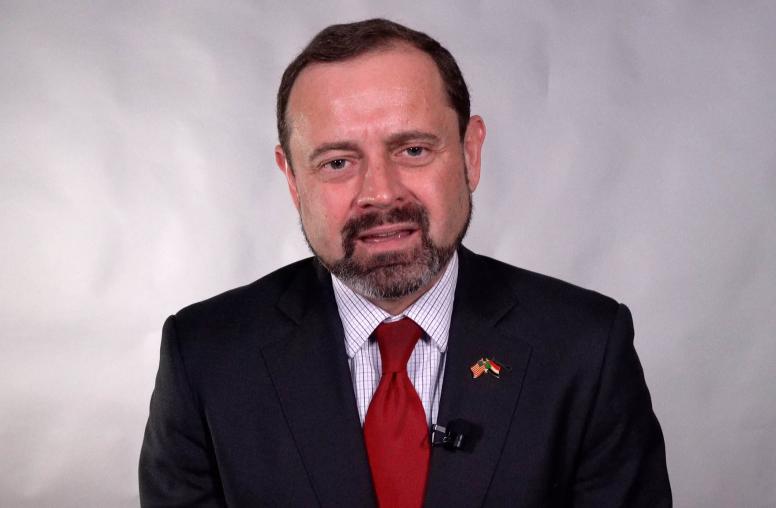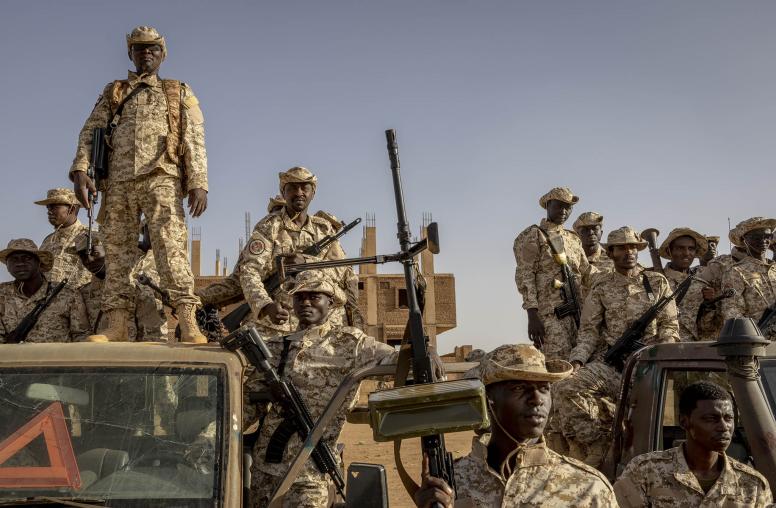Four Priorities for Sudan a Year into the Civil War
A devastating humanitarian crisis and the risk of regional war demand a new approach from the international community.
This week marks a year of war in Sudan. A once promising revolution that led to the overthrow in 2019 of the country’s longtime dictator, Omar al-Bashir, has devolved into a devastating civil war. The fighting started over a dispute on how to incorporate the paramilitary Rapid Support Forces (RSF) into the country’s military, the Sudan Armed Forces (SAF). A year later as the conflict between the RSF and SAF grinds on, Sudan is experiencing the world’s worst displacement crisis and one of the world’s worst hunger crises in recent history.

France held an international conference this week to refocus attention on Sudan’s crisis. But amid escalating violence in the Middle East, sustained fighting in Ukraine and growing tensions in the South China Sea, this catastrophic anniversary is not registering the concern, resources and action needed to avert the deaths of hundreds of thousands of people who are at risk.
Sudan has endured sustained periods of war: the civil war that led to the independence of South Sudan in 2011; the wars in Blue Nile and the Nuba Mountains; the Darfur genocide in the early 2000s; and conflict over the unresolved status of Abyei Area as part Sudan or South Sudan. But tragically, war in Sudan doesn’t make news. History has dulled the impact of headlines. For those who pay attention, the idea of silencing the guns risks seeming too complex. Or worse, it seems that some assume that Sudan’s conflict can persist without significant threats to regional or global peace and security.
The moment facing Sudan, its people, the region and the foundations that underpin our shared principles in the global system demand a sober analysis of what is at stake. Yet, despite the risks to regional peace and security and the immense suffering inflicted on the Sudanese people, the international community’s response has been wholly insufficient.
World’s Largest Displacement and Hunger Crises
More than 10 million people have been forced from their homes, a number roughly equivalent to the entire population of the state of Virginia. Almost 2 million of those people have fled to neighboring Chad, South Sudan and Egypt. Those who have fled include the core of the country’s business, civic and political leaders, university professors and other professionals. People have made one of the most painstaking decisions in their lives: to leave their family homes, their treasured belongings, their neighbors and their country. Spread in every direction, the brain trust of the country has been divided and weakened.
The war has also triggered the world’s worst hunger crisis. At the end of March, nearly 18 million Sudanese were living in acute food insecurity. The collapse of the banking system, the bombing of food production facilities and escalating insecurity in Gezira state, the country’s breadbasket, have exacerbated the situation and made a resolution more difficult. With only 6% of the United Nation’s humanitarian appeal funded, the international resources available are dwarfed by the suffering. Compounding this challenge are the continued barriers to access posed by the fighting parties.
A Risk of Regional War
The risks to peace and security spill beyond Sudan’s border. If the violence continues to escalate in Gezira state, into Eastern Sudan and toward Port Sudan, which sits on the strategic Red Sea, Eritrea, Ethiopia and Egypt are faced with immediate threats and may very well become more directly involved. Sudan’s civil war is already impacting South Sudan.
More than 600,000 people have been displaced into South Sudan, which was already facing serious food, economic and political crises. Over the last month, the most significant oil pipeline, which traverses from South Sudan, through Sudan and up to Port Sudan for onward shipping, has shut down. Engineers cannot gain access to make necessary repairs given the fighting. With 90% of the South Sudan’s revenue literally stuck in a damaged pipeline, South Sudan’s government appears to be turning to the United Arab Emirates to provide a financial lifeline. The stakes for the political economy across East Africa could not be higher.
Over the past decades, critical parts of the international system have been constructed to prevent the worst that humans can inflict on each other and to mobilize the resources, approaches and mechanisms needed to ensure access to education, clean water, health care and peace. These mechanisms emerged after the horrendous violence from the Balkans to Rwanda in the 1990’s, as well as the Darfur genocide in the 2000s.
These institutions — within United Nations agencies, the U.N. Security Council, the African Union, regional bodies and the U.S. government — were designed so that action would be launched as a reflex, not as a matter of debate, a question of priorities, or in response to the expression of righteous anger by peace activists around the world.
Similarly, brokering cease-fires has developed well-refined practices. Tools to leverage targeted pressure on warring parties have been refined, and the U.S., other countries and multilateral institutions have translated tested proof of the effectiveness of including those most impacted by violence, including women, into legal requirements to include women in peace processes.
Yet, as Sudan faces this moment, our global reflexes have failed.
Looking Ahead
As the war enters its second year, advancing four priorities could mitigate the impact of the war and take steps toward silencing the guns and fostering peace:
1. Develop and execute a shared, coherent strategy with the leadership of recently appointed envoys. The appointment of Tom Perriello as U.S. special envoy for Sudan presents an opportunity to reset the U.S. policy approach. Perriello, the U.N. secretary-general’s envoy, Ambassador Ramtane Lamamra, and the chair of the African Union High Level Panel on Sudan, Ambassador Mohamed Chambas, are experienced, respected individuals. But they need to be aligned to be effective. And the work of these exceptional individuals without sufficient staffing, resources and high-level political support will fall short. If the envoys can develop a shared strategy — one that is anchored in the realities of the Horn and Red Sea area and delineated roles — they will be better positioned to provide coordinated global leadership.
2. Prioritize getting humanitarian assistance to those most in need through mechanisms that are most effective. The SAF and RSF appear to remain convinced that war is the most effective way to contest power. Each seems certain that they can “win” the fight. Each is locked into and has mobilized a dangerous narrative to legitimize their violence. Each has armed young men and women in a massive recruitment campaign.
In this context, negotiating a nation-wide cease-fire appears out of reach. Priority can be given to negotiating targeted, time-bound humanitarian access to move in humanitarian supplies that can mitigate the human consequences of the war. Options also need to be prepared to protect civilians and critical infrastructure.
An effective humanitarian response depends on turning the $2.2 billion pledges at the Paris conference into rapid procurement, positioning and movement of critical food and supplies. The Sudanese-led response through the Emergency Response Rooms (ERR) needs to be part of this. These self-help groups have identified, targeted and managed scarce resources for community kitchens and services from doctors, nurses and midwives. The ERR’s model accountability to the communities they serve and safeguard the remaining fabric of Sudanese generosity, democratic principles and nationalism. To date, they have a proven track-record with limited funds. Now is the moment for USAID, the U.N. and other donors to surge flexible financial support as part of the emergency response.
Similarly, women are organizing themselves and activating their vast relationships to assist with negotiating access and pauses in fighting to facilitate humanitarian assistance. Women-led organizations have identified concrete, urgent steps needed to provide services to survivors of conflict-related sexual violence and protection to prevent further risks. These are both immediate humanitarian needs and components that need to be considered in any future cease-fire.
3. De-escalate conflict in locations at most risk of mass violence. The war is not at an equilibrium. El Fasher in Darfur, Gezira state, and in Eastern Sudan are most at risk for escalation. An expansion of violence would have devastating humanitarian impacts. U.N. Secretary-General António Guterres warned this week that hostilities in El Fasher are cause for fresh alarm. Civilians would be caught in the middle of fighting at best and targeted at worst. Armed groups who signed onto a 2020 peace agreement could be mobilized into the war.
Meanwhile, escalation in Gezira state continues to decimate the country’s own food capacity — not just now but for the entire planting season ahead. Gains in battles would only complicate a next round of talks. And the risks of sparking a regional war that spreads to Ethiopia, Eritrea and Egypt are real.
Efforts still can be made to de-escalate. Consistent, persistent phone calls from high-level officials in the U.S., U.N., AU and neighboring states can convey to belligerents that they will be held accountable for military action. Quiet back-channel communications are also needed to give the fighting parties feasible pathways out. Mechanisms can be activated and funded to use open-source satellite imagery and community-based networks to document violations of international humanitarian law and human rights. Public pressure can be applied to those providing weapons, resupply and resources to call on the generals to step back. And if the SAF, RSF and allied forces pause, swift steps can be taken to get them to the table to consolidate commitments.
4. Get back to basics in the next round of talks. A year ago, the U.S.-Saudi brokered talks in Jeddah, Saudi Arabia started as emergency diplomacy. If these talks resume, as anticipated, a different approach is needed. Past efforts to achieve a cease-fire provide useful lessons.
First, effective facilitation requires a shared definition of the shape, scope and scale of the problem driving the violence and options for an end game. This is not an academic exercise but one that requires intensive diplomacy and political effort. Second, we know that peace processes are more effective when women are involved. To date, Sudanese women have largely been excluded from these efforts. Including them offers the best chance of success. This could take different formats. The mediators could establish a structured, consistent and known mechanism to consult regularly with those most impacted by the violence. Or women, youth and frontline responders could be invited to observe the talks, participate in a nearby forum to amplify their shared rejection of the war, or even participate directly in some or all issues.
The case for the international community to help to resolve the crisis is clear in every direction. On humanitarian grounds, the level of human suffering is intolerable. In strategic terms, the risk of collapse in the Horn of Africa and into the Red Sea is a threat to core U.S. and global interests. There are no quick fixes or simple answers – but there are concrete, actionable steps within reach.



